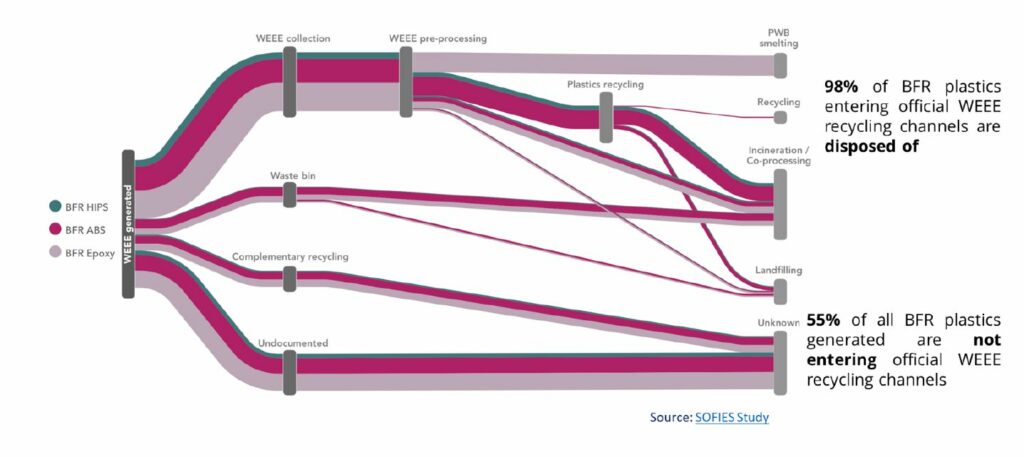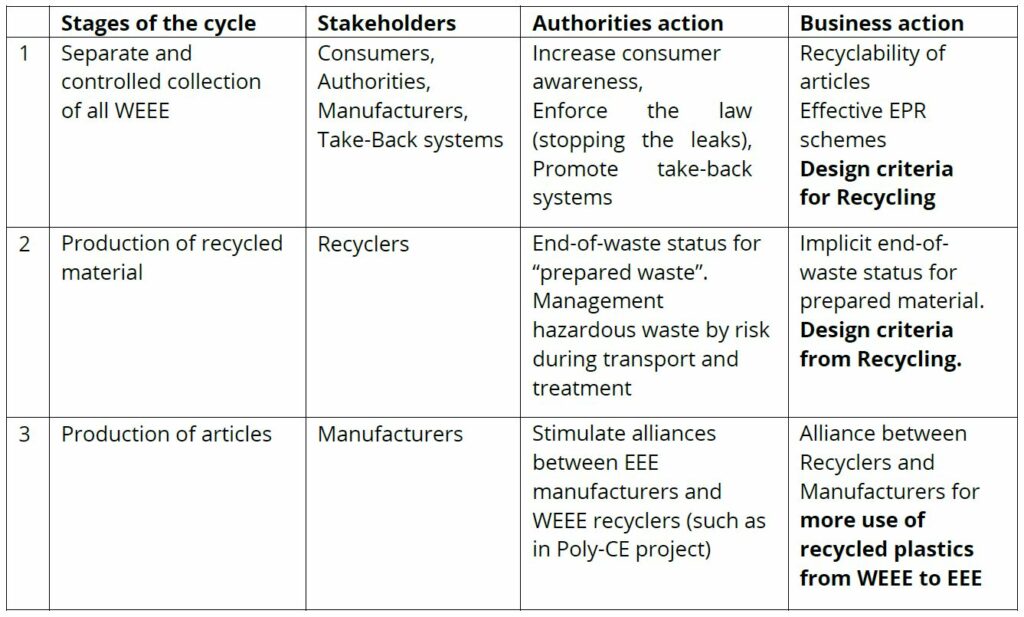Improving the loops of plastics in electronics
 Author: Chris Slijkhuis (cs@eera-recyclers.com) – January 2022
Author: Chris Slijkhuis (cs@eera-recyclers.com) – January 2022
During the IERC 2022 conference in Salzburg from 18 – 21 January, BSEF organized a workshop about WEEE plastics, consisting of a block with presentations and a block consisting of a discussion round table.
Three topics were presented before a round table discussion took place:
1. The impacts of BFR on the recycling of plastics – Federico Magalini SOFIES
2. BFR Thresholds….the never ending discussion – Chris Slijkhuis EERA
3. Technologies for de-toxifying EEE Waste Streams – Luca Campadello ERION
During the workshop and the subsequent discussion round, several important observations and conclusions were made, and it was agreed that EERA would write a summary of the notes and propositions made during this BSEF workshop, to be published on the EERA and BSEF websites. These notes, summarizing the key findings and conclusions of these discussions, were shared to, and reviewed by several participants of the meeting before being distributed.
The key point of the discussion revolved around the issue of the plastic recycling cycle from WEEE to EEE and how both this can be increased by capacity increases and innovations, and at the same time decreasing the dispersion of POP BFR substances.
The discussions revolved around the following topics:
1. Stopping the major leaks of POPs from WEEE
To stop the dispersion of POP BFRs and reduce their loop, the most effective action is to improve the collection rate of WEEE, as was clearly shown by Federico Magalini in his presentation.
The current officially reported collection rate of WEEE plastics is some 55%.
Of the POP BFR containing plastics officially collected, 98 % are separated, and effectively properly disposed of through official WEEE recycling channels.
The WEEE plastics recycling processes are effective to weed out POP BFRs from the officially collected volumes and only 2% of the collected BFR plastics are recycled and continue to be in the loop towards new products (Sofies Report 2020). These recycled WEEE plastics contain concentrations of POP BFRs, below the legal POP UTC, REACH and RoHS thresholds.
The major flow of plastics that contain BFRs, representing 55% of the mass, does not enter the official WEEE collection and recycling route. This is either entering the wastebin (11%, either entering solid waste incinerators or landfills), or entering the complementary treatment of mainly metal recycling routes for the recovery of ferrous and non-ferrous metals (11%) or the flow with unknown management of the material (33%).
The best way of minimising the risk of restricted POP plastic BFRs is that authorities, producers (through their contracted Extended Producer Responsibility take-back organisations), the recyclers and the population must cooperate in increasing the take-back ratio. From experience and literature, together with public campaigns for awareness, financial fees (when buying) and incentives (when bringing back) seems the best solutions. EERA referred to the paper “Towards an EU WEEE Regulation” that was published during the conference.
2. Increasing the amounts of plastics recycled from WEEE
To increase the quantity of plastics recovered from WEEE, innovations to recover PA, filled PP, PMMA and PC are needed. These plastics are in the same density ranges as those plastics with BFRs and they are presently lost. Innovations are underway but need time and alliances between producers and recyclers.
Articles are changing, plastics in articles are changing, additives in plastics are changing, and there are different regulations for the same additive, that are also changing with time. The mass of valuable plastic fractions PE and PP (density < 1 g/cm3), ABS and PS (density < 1.1 g/cm3) in WEEE decreases over time, as the developments over the last 15 years have shown.
The recycling ratio can be maintained only by retrieving other non-brominated plastics from the dense fraction, as the graph shows.
 The “next” valuable families are PA (density between 1.1 and 1.2 g/cm3), PMMA (about 1.12 – 1.20 g/cm3), mineral filled PP types (1.25-1.3 g/ cm3) and PC (about 1.17 – 1.22 g/cm3). The density of the brominated plastics interferes with these densities (1.14 – 1.40 g/cm3), so that density separation cannot be applied anymore and different separation techniques such as sensor-based technologies (Near Infra-Red, Medium Infra-Red, X-ray transmission, X-ray fluorescence) or other, such as solvent based techniques, are required. These new technologies under development were presented by the presentation of the NON-Tox Initiative.
The “next” valuable families are PA (density between 1.1 and 1.2 g/cm3), PMMA (about 1.12 – 1.20 g/cm3), mineral filled PP types (1.25-1.3 g/ cm3) and PC (about 1.17 – 1.22 g/cm3). The density of the brominated plastics interferes with these densities (1.14 – 1.40 g/cm3), so that density separation cannot be applied anymore and different separation techniques such as sensor-based technologies (Near Infra-Red, Medium Infra-Red, X-ray transmission, X-ray fluorescence) or other, such as solvent based techniques, are required. These new technologies under development were presented by the presentation of the NON-Tox Initiative.
Innovation is needed to retrieve these new types of plastics to be recovered from the WEEE plastics fractions. These processes include specific sorting, washing, possible transformation, purification, control, and compounding of formulated pellets ready to be moulded in an article of a product, thus closing the loop. This achievement is only possible with resources (time, know-how, capital) and with the conclusion of alliances with the producers whom these plastics come and for whom the Post-Consumer Recycled WEEE plastics are produced. A good example of such an alliance is the work that was delivered by the Poly-CE project, which resulted in guidelines for and from recycling and also the NONTox project, that is currently underway, is a multi-stakeholder alliance. Such innovation processes typically take 5 years or more. The new recovered polymers must be evaluated for contaminant concentration at the end of the new recycling process, when they constitute a material prepared for use. This requires a stable legal framework with stable thresholds.
As conclusion of the discussion, increasing the collection rate and developing new and innovative techniques to recycle more and other polymers from the WEEE plastics are the only solutions for a more sustainable WEEE plastic management.
3. The assessment of substances must be unified and stable
By the virtue of the circle, the legal assessment of a substance should be stable all along its cycle. Hazardous substances in waste could be managed by risk when the material is under control during the product stages and during the waste stages.
Too many rules and regulations are in place for waste, and for material that is converted into a recycled a secondary raw material, the end-of-waste status means that recyclers are confronted with both waste and product legislations.
Recyclers are faced with complexity and administrative burdens when trying to achieve a circular economy. With the principle of continuity of keeping material in circulation, one substance should have one assessment for all the steps of the loop. Currently the recycling industry is faced with different approaches and thresholds for the same substances in many different rules and regulations, both in waste and product, which all have their review cycles.
The result is that there is no legal stability for this newly developing industry and that therefore the capacities for recycling WEEE plastics do not develop as quickly as they could.
The Circular Economy plan of the European Union specifically mentions the concept of “One-Substance – One Assessment” and this has been promised as well in these Circular Economy plans and when the REACH regulation was introduced in 2006/2007. Following the logic of the circular economy, recycled WEEE plastics should be re-used in the EEE or other similar durable goods. The conclusion of the discussion was that if WEEE is properly managed, the restricted substances it contains – such as BFRs – can be kept harmless during transport and processing, and subsequent use, a risk-based approach can be applied.
The current EU proposals for new Low POP Content threshold for BFRs was discussed at length. WEEE plastics with BFRs are recycled at the end of the recycling path, and if this follows an environmentally sound treated path, properly discarding the restricted BFRs, the Low POP Content does not need to be measured along the chain.
If the Low POP Content thresholds would be reduced below the current values, which were set only 2 years ago, the recycling industry fears that this will logically result in a further reduction of the Unintentional Trace Contaminants, which would have devastating consequences for the further development of the WEEE plastics recycling industry.
The Circular Economy calls for more WEEE plastic capacities and for more innovation.
4. The further development of a circular economy for WEEE plastics.
Today over 3 million Metric Tons of tech-plastic are used in new electronics. Recycling these plastics makes a lot of sense from an environmental point of view, as the energy for the extraction, refining and polymerization and kept in these recycled polymer chains, thus resulting in enormous CO2 and energy savings compared to the production of virgin tech plastics. Today only a small quantity of the WEEE plastics are currently truly circular and this needs to be increased.
The stages of an ideal EEE plastic product cycle follows these steps:
5. Conclusion
The discussion of this WEEE plastics workshop revealed and confirmed that there is requirement for stable thresholds, particularly for restricted BFRs, for better and simpler rules for shipment of WEEE plastics, particularly within the EU, and for a legislative framework that stimulates investments in WEEE plastic capacities and innovations in recycling technologies.
The markets and European consumers are ready to take up more recycled plastics from WEEE. Capacities and innovations of this complex and new recycling industry for WEEE plastics need to be stimulated, by a clearer, simpler, and more stable legal framework.




